数据分析面试必备——SQL你准备好了吗?
2019-05-31 17:03
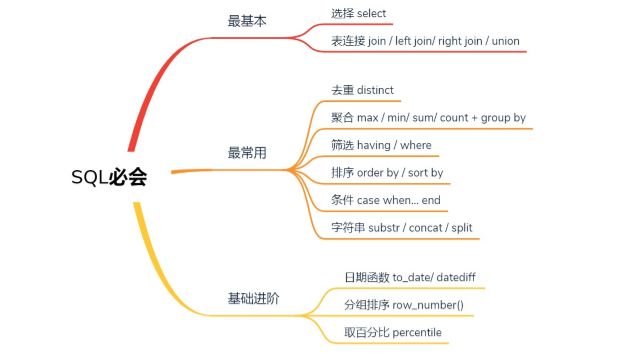
数据分析师的招聘JD你们一定不陌生:

可以说,不是每个数据分析岗都要求python,但是每个数据分析岗都需要会SQL。写这篇文章是希望帮助还没有实战过SQL的小伙伴、或者了解一些SQL语句,但是担心自己了解的太片面的小伙伴。
这篇文章主要介绍的是:如果想要面试数据分析岗位,最优先需要掌握的SQL技能是哪些呢?读完本文,你能快速知道:
1、除了select 这种基本的语句,我最应该马上掌握的SQL语句和知识是什么?
2、面试中SQL题80%都在考察的语法是什么?
3、这些语法应该怎么使用?
本文将从三大块介绍入门SQL需要掌握的语法和知识,分别是最基础的选择(select)和连接(join/union);最常用的函数(distinct/group by/order by等);一些小小的进阶技巧(组内排序、取前百分之多少的值、时间函数)。

一、最基本(选数据)

•怎么把数据从表里选出来?
-- 从table_1中选择a这一列
select a from table_1
•想要的数据在多张表里,想取多个字段,该怎么办?—— 表连接
-- table_1中有id,age; table_2中有id,sex。想取出id,age,sex 三列信息
-- 将table_1,table_2 根据主键id连接起来
select a.id,a.age,b.sex from
(select id,age from table_1) a --将select之后的内容存为临时表a
join
(select id, sex from table_2) b --将select之后的内容存为临时表b
on a.id =b.id
在这里先介绍一下几种join: (敲重点,很容易问的哦)

join :hive的join默认是inner join,找出左右都可匹配的记录;

left join: 左连接,以左表为准,逐条去右表找可匹配字段,如果有多条会逐次列出,如果没有找到则是NULL;

right join:右连接,以右表为准,逐条去左表找可匹配字段,如果有多条会逐次列出,如果没有找到则是NULL;
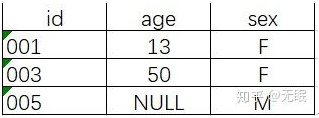
full outer join:全连接,包含两个表的连接结果,如果左表缺失或者右表缺失的数据会填充NULL。
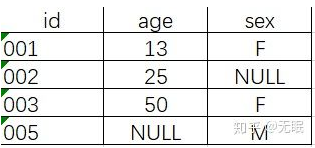
每种join 都有on , on的是左表和右表中都有的字段。join 之前要确保关联键是否去重,是不是刻意保留非去重结果。
•两张表数据的字段一样,想合并起来,怎么办?
-- 不去重,合并两张表的数据
select * from
(
select id from table_1
UNION ALL
select id from table_2
)t;
union和union all 均基于列合并多张表的数据,所合并的列格式必须完全一致。union的过程中会去重并降低效率,union all 直接追加数据。union 前后是两段select 语句而非结果集。

二、最常用

(不是用这个就是用那个,更有可能多重组合)
为方便大家理解每个函数的作用,先建一个表,后面以这个为示例。
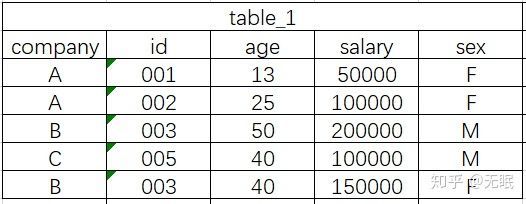
•如果有千万用户数据,想知道有多少去重的用户数?—— 去重 distinct
-- 罗列不同的id
select distinct id from table_1
-- 统计不同的id的个数
select count(distinct id) from table_1
-- 优化版本的count distinct
select count(*) from
(select distinct id from table_1) tb
distinct 会对结果集去重,对全部选择字段进行去重,并不能针对其中部分字段进行去重。使用count distinct进行去重统计会将reducer数量强制限定为1,而影响效率,因此适合改写为子查询。
•想分性别进行统计,看看男女各多少?—— 聚合函数和group by
-- 统计不同性别(F、M)中,不同的id个数
select count(distinct id) from table_1
group by sex
-- 其它的聚合函数例如:max/min/avg/sum
-- 统计最大/最小/平均年龄
select max(age), min(age),avg(age) from
table_1
group by id
聚合函数帮助我们进行基本的数据统计,例如计算最大值、最小值、平均值、总数、求和
•只想查看A公司的男女人数数据?—— 筛选 where/having
-- 统计A公司的男女人数
select count(distinct id) from table_1
where company = 'A'
group by sex
-- 统计各公司的男性平均年龄,并且仅保留平均年龄30岁以上的公司
select company, avg(age) from table_1
where sex = 'M'
group by company
having avg(age)>30;
•希望查询结果从高到低/从低到高排序?—— 排序 order by
-- 按年龄全局倒序排序取最年迈的10个人
select id,age from table_1 order by age DESC
limit 10
•将数值型的变量转化为分类型的变量? —— case when 条件函数
-- 收入区间分组
select id,
(case when CAST(salary as float)<50000 Then '0-5万'
when CAST(salary as float)>=50000 and CAST(salary as float)<100000 then '5-10万'
when CAST(salary as float) >=100000 and CAST(salary as float)<200000 then '10-20万'
when CAST(salary as float)>200000 then '20万以上'
else NULL end
from table_1;
case 函数的格式为(case when 条件1 then value1 else null end), 其中else 可以省,但是end不可以省。
在这个例子里也穿插了一个CAST的用法,它常用于string/int/double型的转换。
•字符串
1.concat( A, B...)返回将A和B按顺序连接在一起的字符串,如:concat('foo', 'bar') 返回'foobar'
select concat('www','.iteblog','.com') from
iteblog;
--得到 www.iteblog.com
2. split(str, regex)用于将string类型数据按regex提取,分隔后转换为array。
-- 以","为分隔符分割字符串,并转化为array
Select split("1,2,3",",")as value_array from table_1;
-- 结合array index,将原始字符串分割为3列
select value_array[0],value_array[1],value_array[2] from
(select split("1,2,3",",")as value_array from table_1 )t
3. substr(str,0,len) 截取字符串从0位开始的长度为len个字符。
select substr('abcde',3,2) from
iteblog;
-- 得到cd
三、基础进阶
•不想全局排序,需要分组排序?—— row_number()
-- 按照字段salary倒序编号
select *, row_number() over (order by salary desc) as row_num from table_1;
-- 按照字段deptid分组后再按照salary倒序编号
select *, row_number() over (partition by deptid order by salary desc) as rank from table_1;
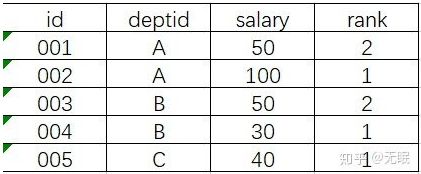
按照depid分组,对salary进行排序(倒序)
除了row_number函数之外,还有两个分组排序函数,分别是rank() 和dense_rank()。
rank()排序相同时会重复,总数不会变 ,意思是会出现1、1、3这样的排序结果;
dense_rank() 排序相同时会重复,总数会减少,意思是会出现1、1、2这样的排序结果。
row_number() 则在排序相同时不重复,会根据顺序排序。
•想要获取top10%的值?—— percentile 百分位函数
-- 获取income字段的top10%的阈值
select percentile(CAST (salary AS int),0.9)) as income_top10p_threshold from table_1;
-- 获取income字段的10个百分位点
select percentile(CAST (salary AS int),array(0.0,0.1,0.2,0.3,0.4,0.5,0.6,0.7,0.8,0.9,1.0)) as income_percentiles
from table_1;
•想要对时间字段进行操作?—— 时间函数
-- 转换为时间数据的格式
select to_date("1970-01-01 00:00:00") as start_time from table_1;
-- 计算数据到当前时间的天数差
select datediff('2016-12-30','2016-12-29');
-- 得到 "1"
to_date函数可以把时间的字符串形式转化为时间类型,再进行后续的计算;
常用的日期提取函数包括:
year()/month()/day()/hour()/minute()/second()
日期运算函数包括datediff(enddate,stratdate) 计算两个时间的时间差(day);
date_sub(stratdate,days) 返回开始日期startdate减少days天后的日期。
date_add(startdate,days) 返回开始日期startdate增加days天后的日期。
四、常见笔试/面试题
例:有3个表S,C,SC:
S(SNO,SNAME)代表(学号,姓名)
C(CNO,CNAME,CTEACHER)代表(课号,课名,教师)
SC(SNO,CNO,SCGRADE)代表(学号,课号,成绩)
问题:
1,找出没选过“黎明”老师的所有学生姓名。
2,列出2门以上(含2门)不及格学生姓名及平均成绩。
3,既学过1号课程又学过2号课所有学生的姓名。
1. -- 考察条件筛选
select sname from s where sno not in
( select sno from sc where cno in
(
select distinct cno from c where cteacher='黎明'
)
);
2. -- 考察聚合函数,条件筛选
select s.sname, avg_grade from s
join
(select sno from sc where scgrade < 60 group by sno having count(*) >= 2) t1
on s.sno = t1.sno
join
(select sno, avg(scgrade) as avg_grade from sc group by sno ) t2
on s.sno = t2.sno;
3. -- 考察筛选、连接
select sname from
( select sno from sc where cno = 1) a
join
(select sno from sc where cno = 2) b
on a.sno = b.sno
这篇SQL面试和笔试的入门文章,主旨是快速、清晰的把握重点。希望大家都能快快入门SQL~